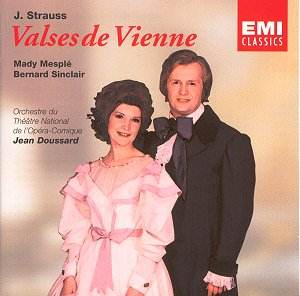This is a re-issue by EMI and forms part of their French
operettas series reviewed elsewhere on Musicweb UK.
The Viennese works of Johann Strauss and his
son, Johann Strauss II need no introduction. The dance scene
of Vienna was set alight with the magic of the strong rhythms and characteristically
spacious strings of Strauss and his followers. The family history of
these remarkable musicians was of much interest to Europeans and Austrians
in particular and the music became a fertile source for pastiche (pasticcio)
operetta. In 1899 Wiener Blut was concocted from Straussian melodies
and other titles followed. Valses of Vienna was originally arranged
by Korngold in 1930 as Waltzes of Vienna and it became more popular
than Wiener Blut. It was written for the Theater an der Wien
in a visually impressive production to cash in on the nostalgia of the
past century at a time after a stock market crash when the Viennese
needed to be comforted by brighter days. Paris saw this French version
shortly afterwards with additional music by Cools and Bittner. As its
popularity spread even an early talkie of Waltzes of Vienna was
filmed in Britain in 1933 by Hitchcock, but because the studio could
not afford the high music royalties some other Strauss pieces were used
instead.
Opening with the Radetzky March one might be
forgiven for thinking one is in a Vienna's New Year's Day concert. A
short voice-over then takes us into the first chorus number which later
becomes a reprise of the March. Readers will be interested to know that
the numbers are not all written in 3/4 time. One has to work hard to
recall the titles of the original music since no help of identification
is given in the brief notes. The interesting pizzicato track [CD1 tk21]
sounds rather modern for a 19th Century composition of the
masters and could be a 1930s creation. In Act III an effective and interesting
musical box effect is used [CD2 tk13]. Later, a delightful arrangement,
reminiscent of something from the pen of Kern perhaps [CD2 tk18] holds
our attention. An uninspired and unmemorable finale eventually rounds
off the operetta.
The performance is distantly miked and thus we have
a disappointing lack of detail. The soloists blend nicely with the Viennese
flavour and the pace set by Doussard is engaging. The diction is poor
but appears to be more do with the poor focus of the recording rather
than the singers' delivery.
Judging by the length of these CDs either the work
is of short duration (less than 90 mins), or the full score and libretto
are not recorded. The synopsis and background notes are provided in
French only.
Raymond Walker


